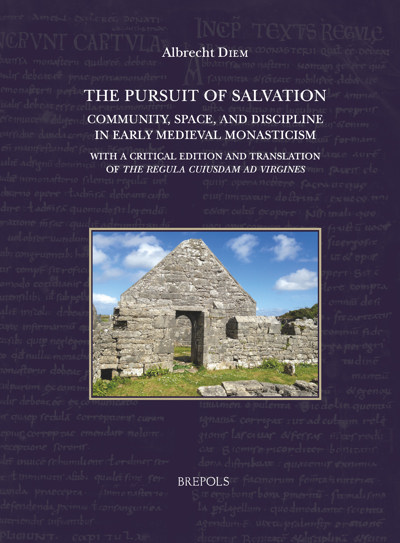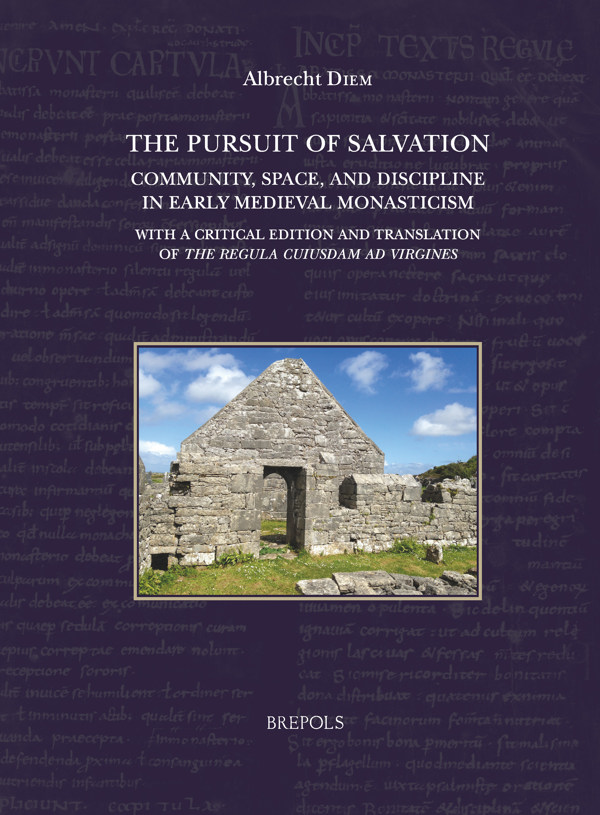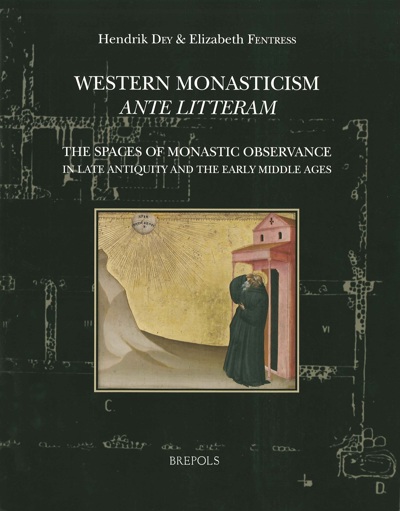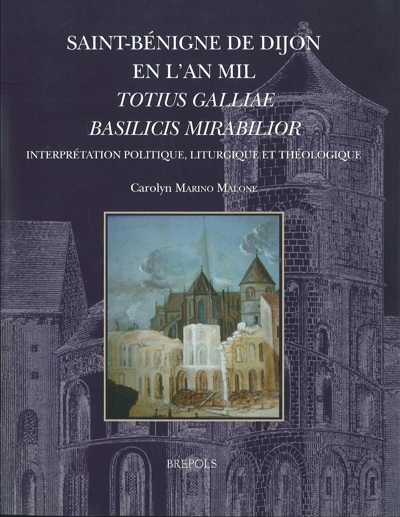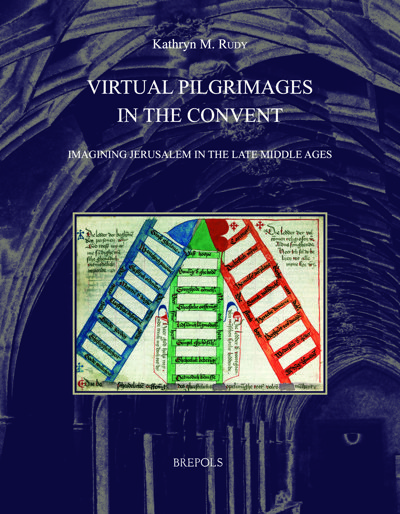
The Pursuit of Salvation. Community, Space, and Discipline in Early Medieval Monasticism
with a critical edition and translation of the Regula cuiusdam ad uirgines
Albrecht Diem
- Pages: 687 p.
- Size:210 x 270 mm
- Illustrations:1 col., 3 tables b/w.
- Language(s):English, Latin
- Publication Year:2021
- € 145,00 EXCL. VAT RETAIL PRICE
- ISBN: 978-2-503-58960-2
- Paperback
- Available
- ISBN: 978-2-503-58961-9
- E-book
- Available
Available in Open Access on BrepolsOnline
A history of the monastic pursuit of eternal salvation in the early medieval West, revolving around a seventh-century monastic rule for nuns, the Regula cuiusdam ad uirgines ("Someone’s Rule for Virgins")
“In sum this book brings together the key insights of Diem’s important methodological work on this and other early monastic rules and makes useful contributions to the debate on the persistence or otherwise of Columbanian monasticism and the early spread of the Benedictine rule. While it will be of great interest to specialists in the field, many of its conclusions will be controversial.” (Katrina Edwards, in Journal of the Australian Early Medieval Association, 24.02.2022, p. 209)
“Die lebendige und bildreiche Sprache des Werkes, in dem so mancher originelle Vergleich und manche Wendung aus Vorträgen erhalten geblieben ist, weckt Lust darauf, dieser Einladung zu folgen und, wenn man einmal dabei ist, noch ein bisschen zu bleiben. Bleiben wird auch dieses Buch, denn an der hier unternommenen Herkulesaufgabe einer Darstellung der Entwicklung des westlichen Klosterwesens wird man auf absehbare Zeit nicht vorbeikommen, auch wenn man in dem einen oder anderen Punkt anderer Meinung sein sollte.” (Arnold Otto, in Jahrbuch für mitteldeutsche Kirchen- und Ordensgeschichte, 18, 2022, p. 286)
“At first glance, this book looks like a critical edition, English translation, and extensive commentary on the Regula cuiusdam ad uirgines, a seventh-century monastic rule that was written for a female community. However, this study is much more than that. Albrecht Diem takes the Regula cuiusdam ad uirgines as a starting point for a broader investigation of early medieval monasticism: he analyses the role of monastic discipline and space, as well as the function of monastic communities in the salvation process. For this purpose, Diem draws on his own in-depth and long-term research on early medieval monastic rules. (...) Throughout his work, Diem diligently combines philological with historical and theological investigation, which makes this publication extremely valuable.” (Rahel Schär, in Early Medieval Europe, 31.2, 2023, pp. 1-3)
“Although Diem’s focus is on a single relatively brief work, the Regula cuiusdam ad uirgines, he uses this as the foundation on which to build a complex, thoughtful, and illuminating discussion of early medieval monasticism as a whole. In doing so, Diem challenges a range of long-held theories and assumptions. Although some scholars may disagree with specific elements of his case, all who work in this area will need to grapple with it going forward. (...) Although the Regula cuiusdam ad uirgines is his ostensible focus, he sets it into conversation with a very wide range of other materials, to illustrate the author’s decision-making processes, as well as the text’s reception. This is a constantly intertextual discussion, and Diem displays his familiarity with the intricacies of monastic materials in the process.” (Lisa Kaaren Bailey, in Studies in Late Antiquity, 7.2, 2023, p. 327)
« D’un point de vue méthodologique, on retiendra que l’étude d’A.D. est la première à centrer l’étude de la tradition monastique sur une analyse purement lexicographique. Elle ouvre ainsi une voie et montre l’intérêt que les historiens pourraient tirer de la mise en place d’une véritable base d’interrogation des textes monastiques du haut Moyen Âge, si du moins il leur est aussi possible d’avancer dans le même temps vers une méthodologie affinée de l’analyse de l’intertextualité et des champs lexicaux. » (Laurent Ripart, dans RMA, 291, 2023, p. 246)
“By this book and the studies that preceded it, Diem has provided an authoritative and extensive source and content analysis of the Regula cuiusdam ad virgines. He does so, in Jonas’s words, with attention and zeal, or, we might say, with a great deal of work and study. He details how Jonas used the Rule of Benedict, but also corrected it to fit his own ideas about how the nuns for whom he was writing should live. All students of pre-Carolingian monasticism in the Latin West are much beholden to Professor Diem.” (Hugh Feiss, O.S.B, in The American Benedictine Review, 74/4, 2023, p. 459)
Albrecht Diem, Associate Professor of Late Antique and Early Medieval History at Syracuse University
The seventh-century Regula cuiusdam ad uirgines (Someone’s Rule for Virgins), which was most likely written by Jonas of Bobbio, the hagiographer of the Irish monk Columbanus, forms an ideal point of departure for writing a new history of the emergence of Western monasticism understood as a history of the individual and collective attempt to pursue eternal salvation.
The book provides a critical edition and translation of the Regula cuiusdam ad uirgines and a roadmap for such a new history revolving around various aspects of monastic discipline, such as the agency of the community, the role of enclosure, authority and obedience, space and boundaries, confession and penance, sleep and silence, excommunication and expulsion.
Introduction
Edition and Translation of the Regua cuiusdam ad uirgines
Part I: Community
Chapter 1: Quidam pater – quaedam mater? The Regula cuiusdam ad uirgines and its Author
Chapter 2: The Dying Nuns of Faremoutiers. The Regula in Action
Part II: Space
Chapter 3: The Regula cuiusdam ad uirgines, a Supplement to Caesarius’ Rule for Nuns?
Chapter 4: Enclosure Re-opened: Caesarius, Jonas, and the Invention of Sacred Space
Part III: Discipline
Chapter 5: The Regula Benedicti in Seventh-Century Francia
Chapter 6: The Regula cuiusdam ad uirgines and its Context
Part IV: Salvation
Chapter 7: De accedendo ad Deum – A Lost Chapter of the Regula cuiusdam ad uirgines?
Chapter 8: Prompto corde orandum: The Theological Program of De accedendo
Conclusion
Three appendices
Bibliography of manuscripts, sources, and literature
Index uerborum
